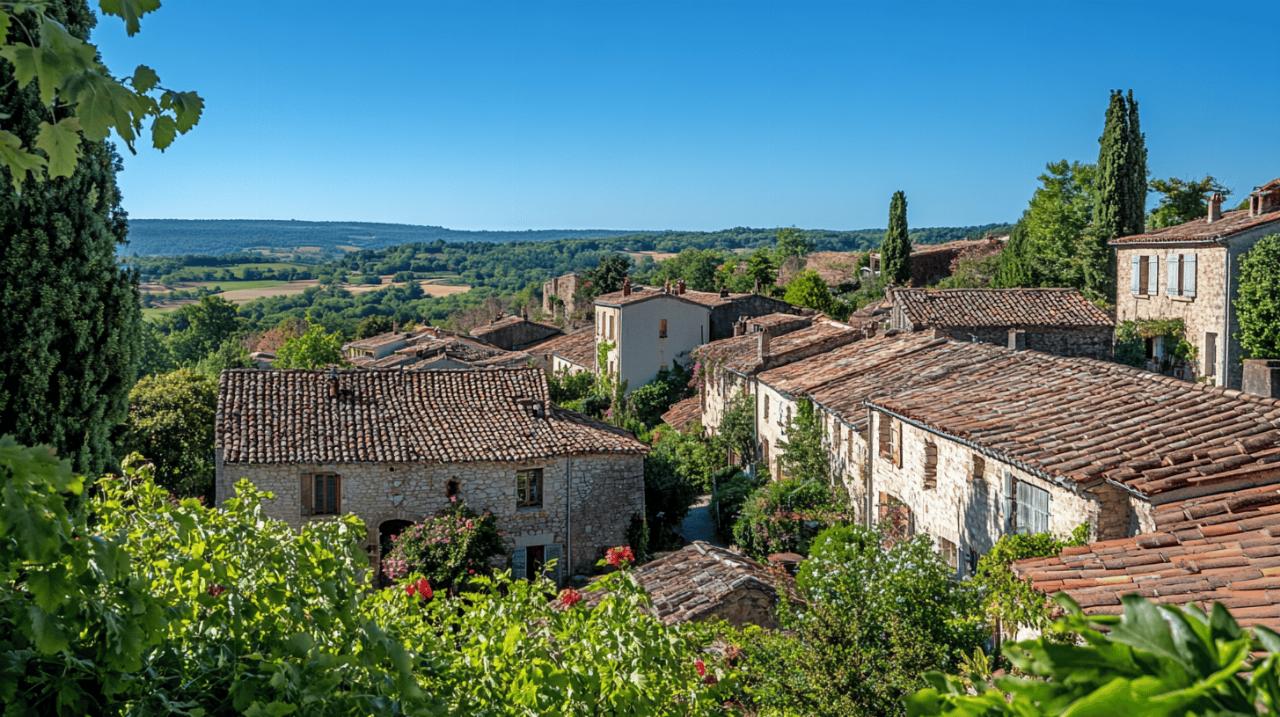Welcome to the enchanting world of Castelnau-de-Montmiral, a medieval treasure nestled in the heart of the Tarn region. This fortified village, with its rich history dating back to 1220, has earned its place among the Most Beautiful Villages of France and joined the prestigious Grands Sites Occitanie in 2018. As you wander through its cobblestone streets, the village reveals its timeless charm and vibrant community spirit, orchestrated by the dedicated Mairie that keeps this cultural gem thriving.
The enchanting landscape of castelnau-de-montmiral
A Gem Nestled in the Tarn Countryside
Perched amidst the rolling hills of the Tarn countryside, Castelnau-de-Montmiral lives up to its poetic name, which translates to “Mountainfromwhereyoucansee.” The panoramic views stretch across the lush Vère valley and the dense Grésigne forest, creating a breathtaking backdrop for this medieval masterpiece. With a modest population of 1046 inhabitants, the village offers a perfect escape from urban bustle while remaining accessible – just 70 kilometres from Toulouse, making it an ideal day trip or weekend retreat.
The physical landscape is matched by its architectural splendour, with half-timbered houses lining narrow cobblestone streets that wind their way through centuries of history. Every corner tells a story, every stone building reflects the Occitan heritage that defines this region, creating an atmosphere that transports visitors to another time.
Cultural significance and local traditions
The cultural heart of Castelnau-de-Montmiral beats strongest during its various festivals and market days. The village comes alive during the Red Lands festival in July, while August brings the vibrant celebrations of Castel'roc and the delightful honey fair. These events showcase the deep connection between the community and its agricultural roots, particularly evident in the renowned Gaillac wines produced in the surrounding vineyards.
Perhaps no tradition better exemplifies the village spirit than the Tuesday morning market, a weekly gathering that has taken place for generations. From 8am to 12pm, locals and visitors alike converge on the village to purchase fresh, seasonal produce directly from regional farmers. The market transforms the ancient streets into a lively hub of conversation, commerce, and community bonding, offering everything from artisanal cheeses and saucisson to foie gras and vegetables grown in the fertile Tarn soil.
The Historical Evolution of the Mairie and Its Commune
From medieval origins to present-day governance
The story of Castelnau-de-Montmiral began in 1222 when Count Raymond VII of Toulouse established this fortified settlement as part of a strategic defensive network. Throughout the centuries, the village weathered the turbulent tides of French history, including the Revolution which saw the destruction of its castle. Despite these challenges, the community persevered, maintaining its distinctive character while adapting to changing times.
Today, the Mairie stands as both a physical building and a symbol of local governance, continuing a tradition of civic leadership that stretches back to medieval times. This administrative heart ensures the preservation of heritage while guiding the village into the future. The building itself, located near the Place du Souvenir, embodies the architectural style and historical significance that earned Castelnau-de-Montmiral recognition as one of the Most Beautiful Villages of France.
The mairie's role in community welfare
The Mairie of Castelnau-de-Montmiral serves as more than an administrative centre; it functions as the guardian of community welfare and local traditions. Under its guidance, the village has embraced modern conveniences while preserving its historical character, evidenced by thoughtful additions such as the electric car charging point near the supermarket and free parking behind the community hall.
Through careful stewardship, the Mairie helps maintain the delicate balance between tourism and everyday life for residents. It oversees the preservation of architectural heritage, supports local businesses around the magnificent Place des Arcades, and ensures that visitors can discover the village through initiatives like the EnQuête(s) app, which offers innovative ways to explore the medieval streets and learn about local history.
Discovering castelnau-de-montmiral through local maps
Hidden treasures and must-visit spots
 A glance at the local map reveals a village brimming with historical and cultural treasures. At its heart lies the magnificent Place des Arcades, surrounded by medieval buildings that now house charming shops and restaurants such as L'Auberge des Arcades, where visitors can sample regional cuisine starting from 24 euros. Nearby stands the Church of the Assumption, home to the remarkable Cross of the Consuls, an exquisite piece of goldwork that represents the spiritual heritage of the community.
A glance at the local map reveals a village brimming with historical and cultural treasures. At its heart lies the magnificent Place des Arcades, surrounded by medieval buildings that now house charming shops and restaurants such as L'Auberge des Arcades, where visitors can sample regional cuisine starting from 24 euros. Nearby stands the Church of the Assumption, home to the remarkable Cross of the Consuls, an exquisite piece of goldwork that represents the spiritual heritage of the community.
Beyond the village centre, local maps guide adventurous visitors to a network of hiking trails that showcase the natural beauty of the surrounding countryside. The Gradille Path offers a 9-kilometre journey taking approximately 2 hours and 40 minutes, while more ambitious explorers might tackle the Baroness Trail or the Lagarde Castle Trail, both spanning 13 kilometres and offering immersive experiences in the verdant landscape that cradles Castelnau-de-Montmiral.
Seasonal events and market days
Throughout the year, the village calendar fills with events that celebrate local culture and produce. The Tourist Office, conveniently located on Place aux Arcades, provides visitors with up-to-date information about upcoming festivities and practical details for making the most of their stay. Opening hours vary seasonally, reflecting the ebb and flow of tourism throughout the year.
Market days transform Castelnau-de-Montmiral into a vibrant hub of activity. Every Tuesday morning, from January through December, the village hosts a producers' market where visitors can purchase directly from local farmers and artisans. This tradition connects modern visitors with centuries of commerce in the same historic square, creating an authentic experience that goes beyond typical tourism. For those exploring the broader Tarn region, similar markets occur throughout the week in neighbouring towns such as Albi, Castres, and Gaillac, each with its own distinct character.
Tales and Trivia from the Heart of Tarn
Remarkable characters who shaped the village
The history of Castelnau-de-Montmiral is enriched by the stories of those who called it home through the centuries. Count Raymond VII of Toulouse, who founded the village in 1222, envisioned a strategic fortification that would stand the test of time. His foresight created not merely a defensive structure but the foundation for a community that would flourish for over eight centuries, developing its unique cultural identity while remaining connected to the broader Occitan heritage.
The village draws its name from its commanding position in the landscape, allowing sentinels to survey the surrounding countryside for approaching threats or welcome friends. This strategic advantage transformed over centuries into an aesthetic one, as the panoramic views now delight visitors rather than inform military decisions. The consuls who once governed the medieval community left their mark most visibly in the magnificent Cross of the Consuls, a testament to the wealth and artistic appreciation that flourished even in this relatively small settlement.
Curious customs and local legends
The gastronomic traditions of Castelnau-de-Montmiral tell their own story of regional identity and agricultural bounty. Local dishes feature duck prominently, with magret de canard and cassoulet appearing on many menus alongside foie gras and artisanal cheeses. These culinary customs reflect generations of farming practices and food preparation techniques passed down through families and celebrated in community gatherings.
For those seeking accommodation immersed in local culture, options range from the Hotel des Consuls starting at 71 euros per night to more luxurious stays at La Petite Toscane for 239 euros. The aptly named La Petite Toscane hints at another fascinating aspect of the region – its landscape reminiscent of Tuscany has created a French counterpart to the Italian countryside, earning it the nickname that acknowledges the visual similarities between these two storied wine regions. As visitors sip Gaillac wines while gazing across the undulating landscape, they participate in a tradition of appreciation that spans cultures and centuries.

